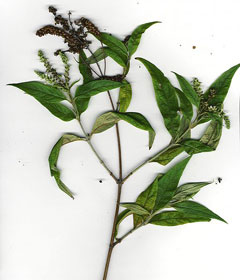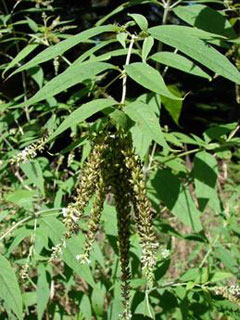 |
|
http://commons.wikimedia.org/wiki/User:BotMultichill |
 |
| http://www.hear.org/starr/ |
Translate this page:
Summary
Physical Characteristics

 Buddleia asiatica is an evergreen Shrub growing to 3 m (9ft) by 3 m (9ft).
Buddleia asiatica is an evergreen Shrub growing to 3 m (9ft) by 3 m (9ft).
See above for USDA hardiness. It is hardy to UK zone 8. It is in leaf all year, in flower from January to April. The species is dioecious (individual flowers are either male or female, but only one sex is to be found on any one plant so both male and female plants must be grown if seed is required). and is pollinated by Bees, Lepidoptera (Moths & Butterflies). The plant is not self-fertile.
Suitable for: light (sandy), medium (loamy) and heavy (clay) soils, prefers well-drained soil and can grow in nutritionally poor soil. Suitable pH: mildly acid, neutral and basic (mildly alkaline) soils and can grow in very alkaline soils.
It cannot grow in the shade. It prefers dry or moist soil and can tolerate drought. It can tolerate atmospheric pollution.
UK Hardiness Map
US Hardiness Map
Synonyms
Buddleja asiatica
Plant Habitats
Woodland Garden Sunny Edge; Dappled Shade;
Edible Uses
Edible Parts:
Edible Uses: Drink
The dried and powdered root is used in the preparation of a fermented liquor[183].
References More on Edible Uses
Medicinal Uses
Plants For A Future can not take any responsibility for any adverse effects from the use of plants. Always seek advice from a professional before using a plant medicinally.
Abortifacient Skin
The plant has been used as an abortifacient and also in the treatment of skin complaints[240, 243]. The juice f the plant is applied as a wash to treat skin diseases[272].
References More on Medicinal Uses
The Bookshop: Edible Plant Books
Our Latest books on Perennial Plants For Food Forests and Permaculture Gardens in paperback or digital formats.

Edible Tropical Plants
Food Forest Plants for Hotter Conditions: 250+ Plants For Tropical Food Forests & Permaculture Gardens.
More

Edible Temperate Plants
Plants for Your Food Forest: 500 Plants for Temperate Food Forests & Permaculture Gardens.
More

More Books
PFAF have eight books available in paperback and digital formats. Browse the shop for more information.
Shop Now
Other Uses
Wood
Wood - tough, moderately hard. It could be used for making walking sticks[158].
Special Uses
Scented Plants
References More on Other Uses
Cultivation details
Requires a sunny position, succeeding in most reasonably good soils so long as they are well-drained[1, 11, 182, 200]. Prefers a rich loamy soil[11]. Plants are very tolerant of alkaline soils[200]. Of doubtful hardiness in most of Britain, it is likely to be damaged or killed by temperatures lower than 0°c[260]. However, one report says that it succeeds outdoors in southern Cornwall[1] whilst other reports say that it might be hardy on a south or south-west facing wall in the mildest areas of this country[11, 166, 182, 188]. So long as the plant is well mulched it resprouts freely from the base if cut back by severe weather[200]. A very ornamental plant[1], the cut flowers last well in water[200]. Hybridizes freely with other members of this genus[200]. Any pruning is best done after flowering[200]. An excellent plant for bees and butterflies. Dioecious. Male and female plants must be grown if seed is required.
References Carbon Farming Information and Carbon Sequestration Information
Temperature Converter
Type a value in the Celsius field to convert the value to Fahrenheit:
Fahrenheit:
The PFAF Bookshop
Plants For A Future have a number of books available in paperback and digital form. Book titles include Edible Plants, Edible Perennials, Edible Trees,Edible Shrubs, Woodland Gardening, and Temperate Food Forest Plants. Our new book is Food Forest Plants For Hotter Conditions (Tropical and Sub-Tropical).
Shop Now
Plant Propagation
Seed - cold stratify for 4 weeks at 4°c[138] and surface sow the seed in February/March in a greenhouse[78, 113] (the pre-chilling might not be required for this species). Germination usually takes place within 3 - 4 weeks at 21°c[138]. When large enough to handle, prick the seedlings out into individual pots and grow them on in the greenhouse for at least their first winter, planting them out into their permanent positions in late spring or early summer, after the last expected frosts. Seedlings are inclined to damp off and so should be watered with care and kept well-ventilated[78]. Cuttings of half-ripe wood, July/August in a frame[11, 113]. Use short side-shoots[78]. Very high percentage[113]. Cuttings of mature wood of the current season's growth, 15 - 20cm long, October/November in a frame[200].
Other Names
If available other names are mentioned here
Native Range
Coming Soon
Weed Potential
Right plant wrong place. We are currently updating this section.
Please note that a plant may be invasive in one area but may not in your area so it's worth checking.
Conservation Status
IUCN Red List of Threatened Plants Status :

Growth: S = slow M = medium F = fast. Soil: L = light (sandy) M = medium H = heavy (clay). pH: A = acid N = neutral B = basic (alkaline). Shade: F = full shade S = semi-shade N = no shade. Moisture: D = dry M = Moist We = wet Wa = water.
Now available:
Food Forest Plants for Mediterranean Conditions
350+ Perennial Plants For Mediterranean and Drier Food Forests and Permaculture Gardens.
[Paperback and eBook]
This is the third in Plants For A Future's series of plant guides for food forests tailored to
specific climate zones. Following volumes on temperate and tropical ecosystems, this book focuses
on species suited to Mediterranean conditions—regions with hot, dry summers and cool, wet winters,
often facing the added challenge of climate change.
Read More
Expert comment
Author
Lour.
Botanical References
11200266
Links / References
For a list of references used on this page please go here
Readers comment
© 2010, Plants For A Future. Plants For A Future is a charitable company limited by guarantee, registered in England and Wales. Charity No. 1057719, Company No. 3204567.